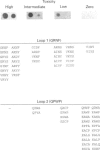Abstract
Site-directed mutagenesis was used to determine the role of two surface-exposed loops (Gly-317-Phe-320 and Gln-374-Pro-377) in the insecticidal specificity of the Bacillus thuringiensis CryIC delta-endotoxin. Mutant toxins were generated by PCR using degenerate oligonucleotide primers, and expressed in Escherichia coli. More than 50 mutant toxins were screened for toxicity to the lepidopteran Spodoptera frugiperda Sf9 cell line using an in vitro lawn assay. A panel of these mutant toxins, which included toxic and non-toxic variants from both loops, was further screened for activity towards Aedes aegypti larvae. The activity of these mutants to Sf9 cells was quantified more precisely using a cell lysis assay. Three categories of mutants were identified: (1) those non-toxic to either Sf9 cells or Aedes aegypti larvae; (2) those fully toxic to both genera; and (3) those which were only toxic to Sf9 cells. For the first loop, the differential specificity was not restricted to any single residue. In the second loop, two mutant toxins with a Pro-377-->Ala substitution displayed this phenotype. The time dependence of toxicity towards Sf9 cells was examined using the same panel of mutants. All toxic mutants displayed an identical time course to the wild-type toxin, with the exception of the two Pro-377-->Ala mutants of the second loop. These toxins displayed a lower time dependence, no cell death occurring within the first hour of incubation. These results show that the two loops are important determinants of both the activity and specificity of the CryIC delta-endotoxin.
Full text
PDF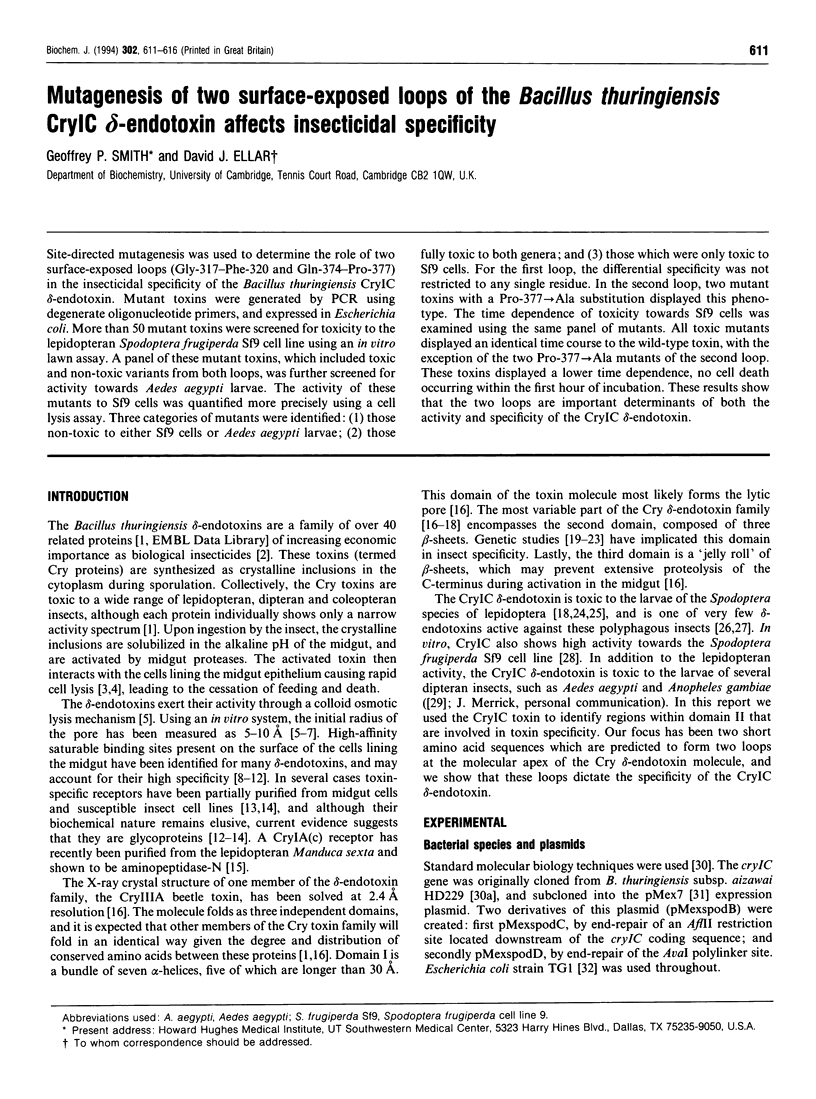
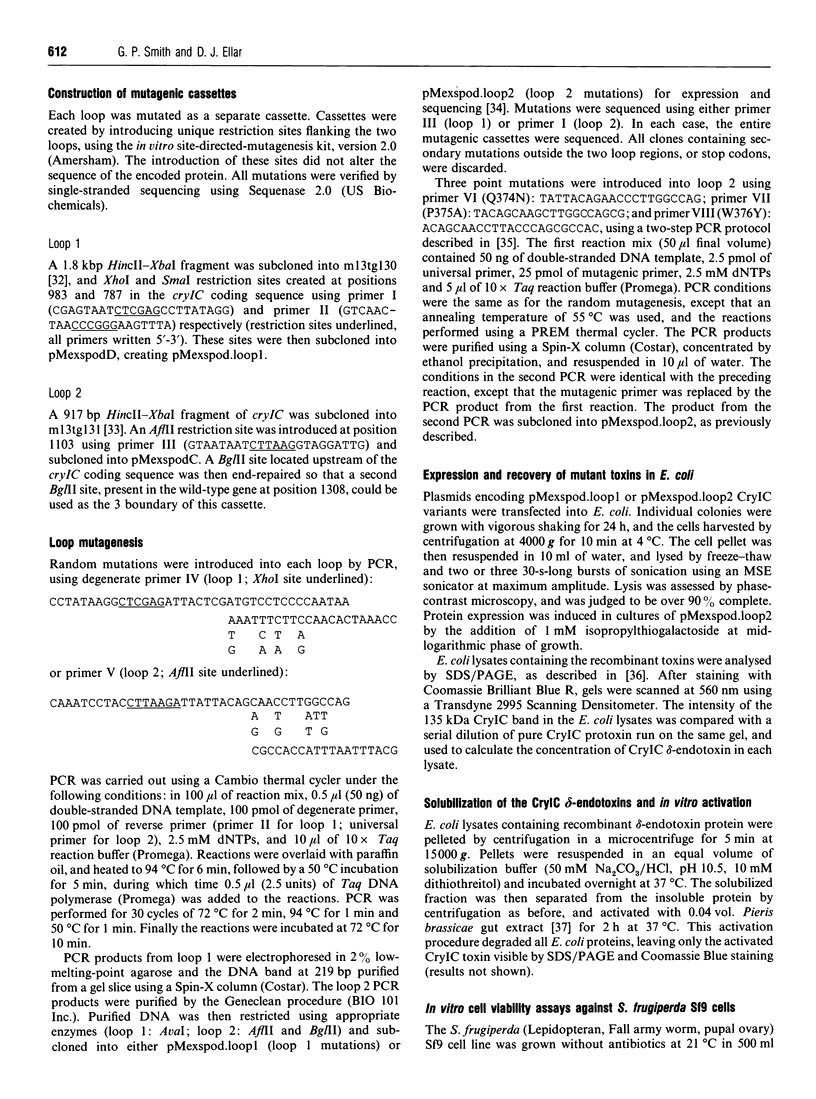
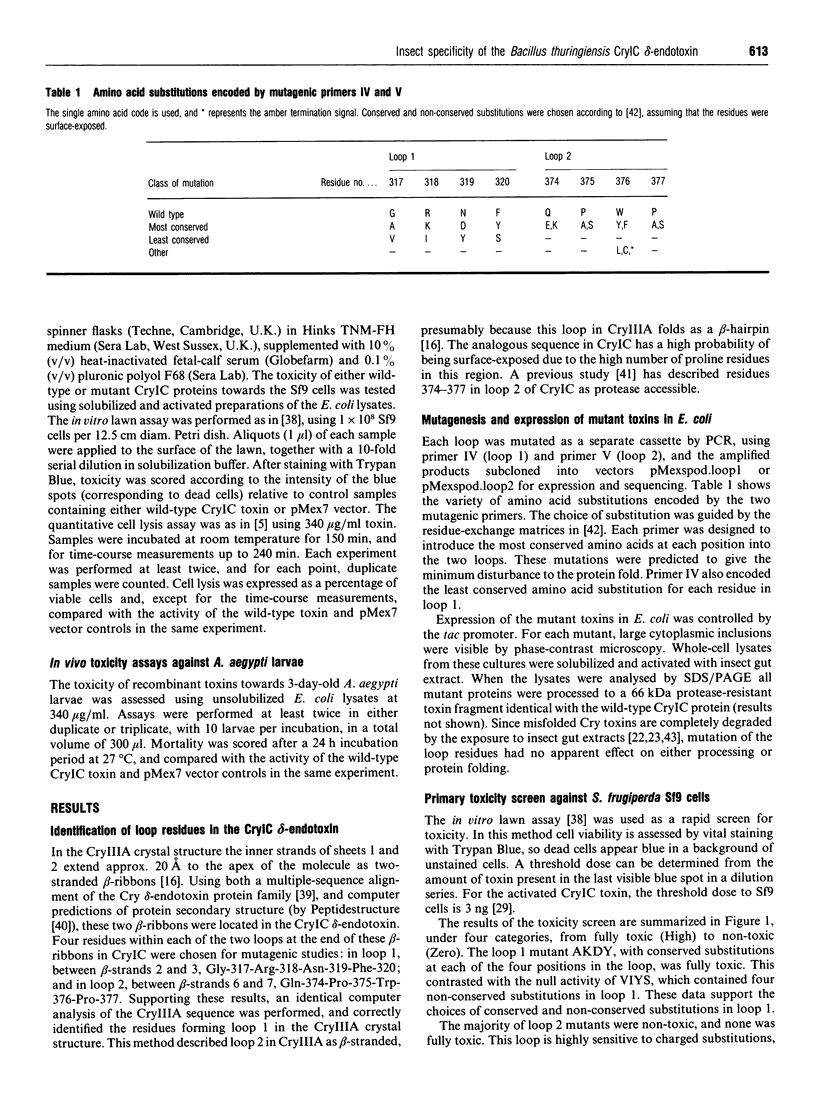
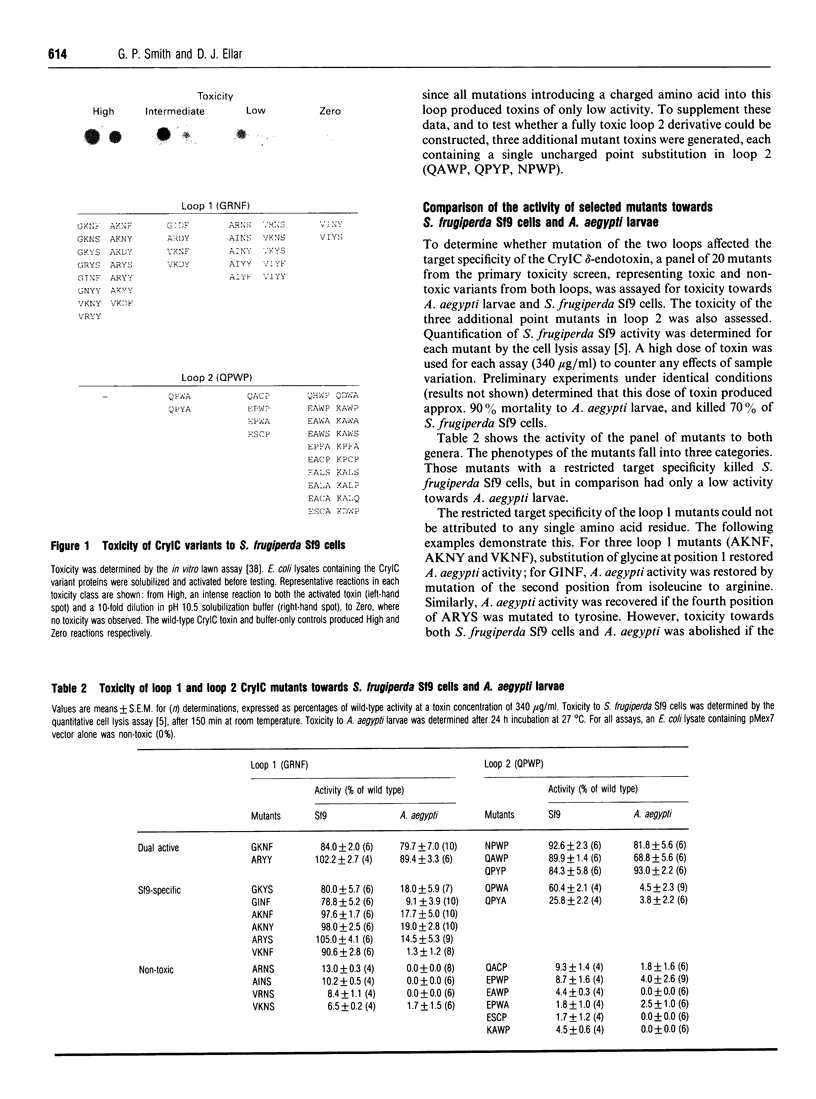
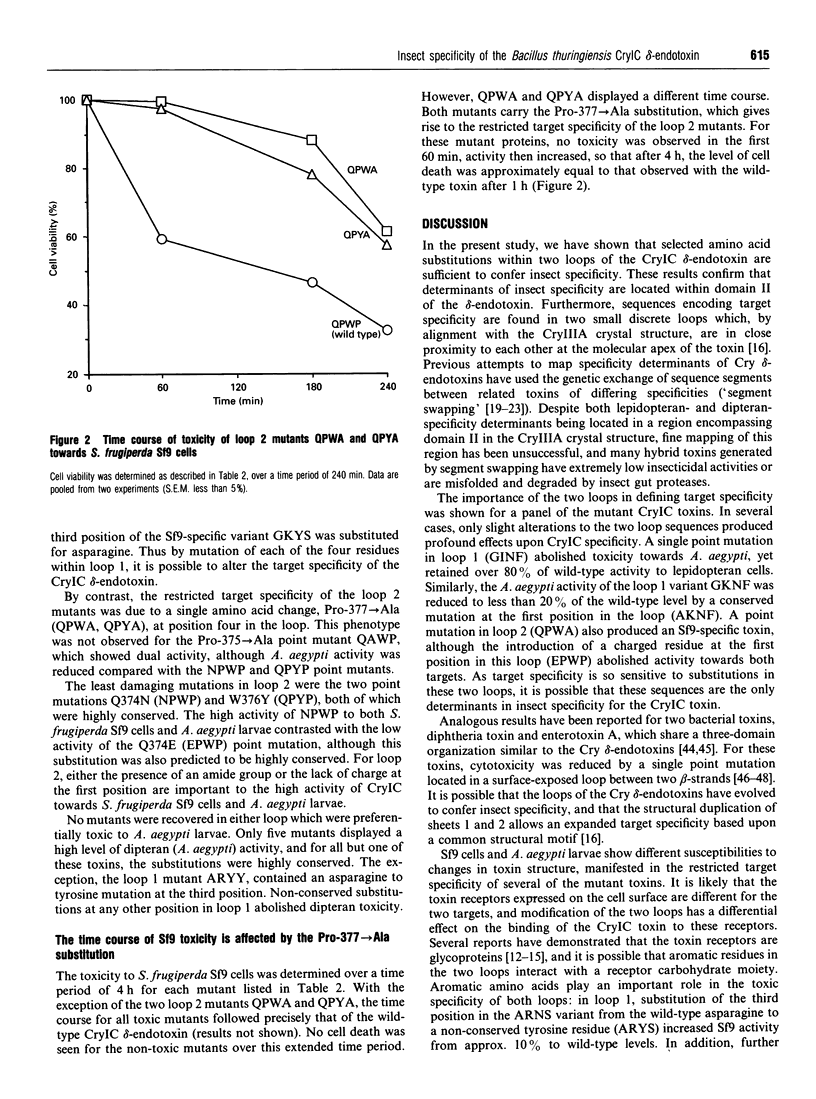
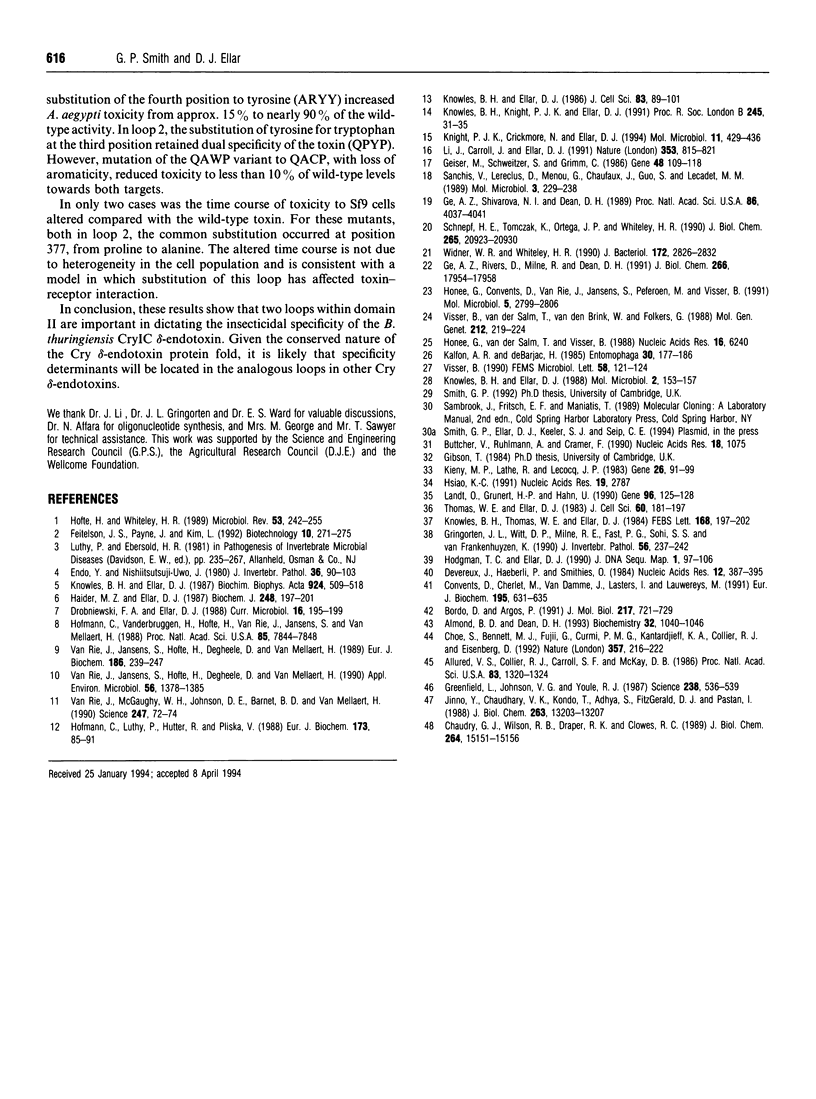
Images in this article
Selected References
These references are in PubMed. This may not be the complete list of references from this article.
- Allured V. S., Collier R. J., Carroll S. F., McKay D. B. Structure of exotoxin A of Pseudomonas aeruginosa at 3.0-Angstrom resolution. Proc Natl Acad Sci U S A. 1986 Mar;83(5):1320–1324. doi: 10.1073/pnas.83.5.1320. [DOI] [PMC free article] [PubMed] [Google Scholar]
- Almond B. D., Dean D. H. Suppression of protein structure destabilizing mutations in Bacillus thuringiensis delta-endotoxins by second site mutations. Biochemistry. 1993 Feb 2;32(4):1040–1046. doi: 10.1021/bi00055a007. [DOI] [PubMed] [Google Scholar]
- Bordo D., Argos P. Suggestions for "safe" residue substitutions in site-directed mutagenesis. J Mol Biol. 1991 Feb 20;217(4):721–729. doi: 10.1016/0022-2836(91)90528-e. [DOI] [PubMed] [Google Scholar]
- Büttcher V., Rühlmann A., Cramer F. Improved single-stranded DNA producing expression vectors for protein manipulation in Escherichia coli. Nucleic Acids Res. 1990 Feb 25;18(4):1075–1075. doi: 10.1093/nar/18.4.1075. [DOI] [PMC free article] [PubMed] [Google Scholar]
- Chaudry G. J., Wilson R. B., Draper R. K., Clowes R. C. A dipeptide insertion in domain I of exotoxin A that impairs receptor binding. J Biol Chem. 1989 Sep 5;264(25):15151–15156. [PubMed] [Google Scholar]
- Choe S., Bennett M. J., Fujii G., Curmi P. M., Kantardjieff K. A., Collier R. J., Eisenberg D. The crystal structure of diphtheria toxin. Nature. 1992 May 21;357(6375):216–222. doi: 10.1038/357216a0. [DOI] [PubMed] [Google Scholar]
- Convents D., Cherlet M., Van Damme J., Lasters I., Lauwereys M. Two structural domains as a general fold of the toxic fragment of the Bacillus thuringiensis delta-endotoxins. Eur J Biochem. 1991 Feb 14;195(3):631–635. doi: 10.1111/j.1432-1033.1991.tb15747.x. [DOI] [PubMed] [Google Scholar]
- Devereux J., Haeberli P., Smithies O. A comprehensive set of sequence analysis programs for the VAX. Nucleic Acids Res. 1984 Jan 11;12(1 Pt 1):387–395. doi: 10.1093/nar/12.1part1.387. [DOI] [PMC free article] [PubMed] [Google Scholar]
- Ge A. Z., Shivarova N. I., Dean D. H. Location of the Bombyx mori specificity domain on a Bacillus thuringiensis delta-endotoxin protein. Proc Natl Acad Sci U S A. 1989 Jun;86(11):4037–4041. doi: 10.1073/pnas.86.11.4037. [DOI] [PMC free article] [PubMed] [Google Scholar]
- Geiser M., Schweitzer S., Grimm C. The hypervariable region in the genes coding for entomopathogenic crystal proteins of Bacillus thuringiensis: nucleotide sequence of the kurhd1 gene of subsp. kurstaki HD1. Gene. 1986;48(1):109–118. doi: 10.1016/0378-1119(86)90357-4. [DOI] [PubMed] [Google Scholar]
- Greenfield L., Johnson V. G., Youle R. J. Mutations in diphtheria toxin separate binding from entry and amplify immunotoxin selectivity. Science. 1987 Oct 23;238(4826):536–539. doi: 10.1126/science.3498987. [DOI] [PubMed] [Google Scholar]
- Gringorten J. L., Witt D. P., Milne R. E., Fast P. G., Sohi S. S., van Frankenhuyzen K. An in vitro system for testing Bacillus thuringiensis toxins: the lawn assay. J Invertebr Pathol. 1990 Sep;56(2):237–242. doi: 10.1016/0022-2011(90)90106-g. [DOI] [PubMed] [Google Scholar]
- Haider M. Z., Ellar D. J. Analysis of the molecular basis of insecticidal specificity of Bacillus thuringiensis crystal delta-endotoxin. Biochem J. 1987 Nov 15;248(1):197–201. doi: 10.1042/bj2480197. [DOI] [PMC free article] [PubMed] [Google Scholar]
- Hodgman T. C., Ellar D. J. Models for the structure and function of the Bacillus thuringiensis delta-endotoxins determined by compilational analysis. DNA Seq. 1990;1(2):97–106. doi: 10.3109/10425179009016037. [DOI] [PubMed] [Google Scholar]
- Hofmann C., Lüthy P., Hütter R., Pliska V. Binding of the delta endotoxin from Bacillus thuringiensis to brush-border membrane vesicles of the cabbage butterfly (Pieris brassicae). Eur J Biochem. 1988 Apr 5;173(1):85–91. doi: 10.1111/j.1432-1033.1988.tb13970.x. [DOI] [PubMed] [Google Scholar]
- Hofmann C., Vanderbruggen H., Höfte H., Van Rie J., Jansens S., Van Mellaert H. Specificity of Bacillus thuringiensis delta-endotoxins is correlated with the presence of high-affinity binding sites in the brush border membrane of target insect midguts. Proc Natl Acad Sci U S A. 1988 Nov;85(21):7844–7848. doi: 10.1073/pnas.85.21.7844. [DOI] [PMC free article] [PubMed] [Google Scholar]
- Honée G., Convents D., Van Rie J., Jansens S., Peferoen M., Visser B. The C-terminal domain of the toxic fragment of a Bacillus thuringiensis crystal protein determines receptor binding. Mol Microbiol. 1991 Nov;5(11):2799–2806. doi: 10.1111/j.1365-2958.1991.tb01988.x. [DOI] [PubMed] [Google Scholar]
- Honée G., van der Salm T., Visser B. Nucleotide sequence of crystal protein gene isolated from B. thuringiensis subspecies entomocidus 60.5 coding for a toxin highly active against Spodoptera species. Nucleic Acids Res. 1988 Jul 11;16(13):6240–6240. doi: 10.1093/nar/16.13.6240. [DOI] [PMC free article] [PubMed] [Google Scholar]
- Hsiao K. A fast and simple procedure for sequencing double stranded DNA with sequenase. Nucleic Acids Res. 1991 May 25;19(10):2787–2787. doi: 10.1093/nar/19.10.2787. [DOI] [PMC free article] [PubMed] [Google Scholar]
- Höfte H., Whiteley H. R. Insecticidal crystal proteins of Bacillus thuringiensis. Microbiol Rev. 1989 Jun;53(2):242–255. doi: 10.1128/mr.53.2.242-255.1989. [DOI] [PMC free article] [PubMed] [Google Scholar]
- Jinno Y., Chaudhary V. K., Kondo T., Adhya S., FitzGerald D. J., Pastan I. Mutational analysis of domain I of Pseudomonas exotoxin. Mutations in domain I of Pseudomonas exotoxin which reduce cell binding and animal toxicity. J Biol Chem. 1988 Sep 15;263(26):13203–13207. [PubMed] [Google Scholar]
- Kieny M. P., Lathe R., Lecocq J. P. New versatile cloning and sequencing vectors based on bacteriophage M13. Gene. 1983 Dec;26(1):91–99. doi: 10.1016/0378-1119(83)90039-2. [DOI] [PubMed] [Google Scholar]
- Knight P. J., Crickmore N., Ellar D. J. The receptor for Bacillus thuringiensis CrylA(c) delta-endotoxin in the brush border membrane of the lepidopteran Manduca sexta is aminopeptidase N. Mol Microbiol. 1994 Feb;11(3):429–436. doi: 10.1111/j.1365-2958.1994.tb00324.x. [DOI] [PMC free article] [PubMed] [Google Scholar]
- Knowles B. H., Ellar D. J. Characterization and partial purification of a plasma membrane receptor for Bacillus thuringiensis var. kurstaki lepidopteran-specific delta-endotoxin. J Cell Sci. 1986 Jul;83:89–101. doi: 10.1242/jcs.83.1.89. [DOI] [PubMed] [Google Scholar]
- Knowles B. H., Ellar D. J. Differential specificity of two insecticidal toxins from Bacillus thuringiensis var. aizawai. Mol Microbiol. 1988 Jan;2(1):153–157. doi: 10.1111/j.1365-2958.1988.tb00016.x. [DOI] [PubMed] [Google Scholar]
- Knowles B. H., Knight P. J., Ellar D. J. N-acetyl galactosamine is part of the receptor in insect gut epithelia that recognizes an insecticidal protein from Bacillus thuringiensis. Proc Biol Sci. 1991 Jul 22;245(1312):31–35. doi: 10.1098/rspb.1991.0084. [DOI] [PubMed] [Google Scholar]
- Knowles B. H., Thomas W. E., Ellar D. J. Lectin-like binding of Bacillus thuringiensis var. kurstaki lepidopteran-specific toxin is an initial step in insecticidal action. FEBS Lett. 1984 Mar 26;168(2):197–202. doi: 10.1016/0014-5793(84)80245-8. [DOI] [PubMed] [Google Scholar]
- Landt O., Grunert H. P., Hahn U. A general method for rapid site-directed mutagenesis using the polymerase chain reaction. Gene. 1990 Nov 30;96(1):125–128. doi: 10.1016/0378-1119(90)90351-q. [DOI] [PubMed] [Google Scholar]
- Li J. D., Carroll J., Ellar D. J. Crystal structure of insecticidal delta-endotoxin from Bacillus thuringiensis at 2.5 A resolution. Nature. 1991 Oct 31;353(6347):815–821. doi: 10.1038/353815a0. [DOI] [PubMed] [Google Scholar]
- Sanchis V., Lereclus D., Menou G., Chaufaux J., Guo S., Lecadet M. M. Nucleotide sequence and analysis of the N-terminal coding region of the Spodoptera-active delta-endotoxin gene of Bacillus thuringiensis aizawai 7.29. Mol Microbiol. 1989 Feb;3(2):229–238. doi: 10.1111/j.1365-2958.1989.tb01812.x. [DOI] [PubMed] [Google Scholar]
- Schnepf H. E., Tomczak K., Ortega J. P., Whiteley H. R. Specificity-determining regions of a lepidopteran-specific insecticidal protein produced by Bacillus thuringiensis. J Biol Chem. 1990 Dec 5;265(34):20923–20930. [PubMed] [Google Scholar]
- Thomas W. E., Ellar D. J. Bacillus thuringiensis var israelensis crystal delta-endotoxin: effects on insect and mammalian cells in vitro and in vivo. J Cell Sci. 1983 Mar;60:181–197. doi: 10.1242/jcs.60.1.181. [DOI] [PubMed] [Google Scholar]
- Van Rie J., Jansens S., Höfte H., Degheele D., Van Mellaert H. Receptors on the brush border membrane of the insect midgut as determinants of the specificity of Bacillus thuringiensis delta-endotoxins. Appl Environ Microbiol. 1990 May;56(5):1378–1385. doi: 10.1128/aem.56.5.1378-1385.1990. [DOI] [PMC free article] [PubMed] [Google Scholar]
- Van Rie J., Jansens S., Höfte H., Degheele D., Van Mellaert H. Specificity of Bacillus thuringiensis delta-endotoxins. Importance of specific receptors on the brush border membrane of the mid-gut of target insects. Eur J Biochem. 1989 Dec 8;186(1-2):239–247. doi: 10.1111/j.1432-1033.1989.tb15201.x. [DOI] [PubMed] [Google Scholar]
- Van Rie J., McGaughey W. H., Johnson D. E., Barnett B. D., Van Mellaert H. Mechanism of insect resistance to the microbial insecticide Bacillus thuringiensis. Science. 1990 Jan 5;247(4938):72–74. doi: 10.1126/science.2294593. [DOI] [PubMed] [Google Scholar]
- Widner W. R., Whiteley H. R. Location of the dipteran specificity region in a lepidopteran-dipteran crystal protein from Bacillus thuringiensis. J Bacteriol. 1990 Jun;172(6):2826–2832. doi: 10.1128/jb.172.6.2826-2832.1990. [DOI] [PMC free article] [PubMed] [Google Scholar]



